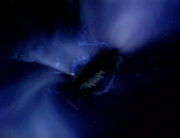
Theoretical appearance of a subspace rupture.
A subspace rupture is an anomaly in subspace.
In the mid-23rd century, a subspace rupture was discovered in the Hanoli star system. A Vulcan starship crew investigated it and detonated a pulse wave torpedo in the tear. This caused the rupture to expand, destroying the Vulcans and the entire Hanoli system. The rupture reached critical mass and disappeared.
In 2369, Jadzia Dax, researching a rupture near Deep Space 9, read about the Hanoli subspace rupture. A group of aliens studying humanoid imaginations made the subspace rupture real, which the crew tried in vain to study before it "destroyed" the station, before Benjamin Sisko realised it too was part of their imaginations. (DS9 episode: "If Wishes Were Horses")
The verteron cascade from the Orbs of the Pah-wraith can create subspace ruptures. (DS9 video game: The Fallen)
In the mid-2370s, the Aerie-class starship USS Swift was assigned to Sector 15120 to study subspace ruptures. (Decipher RPG module: Starships)
Appendices[]
Connections[]
| spatial phenomena | |
|---|---|
| space weather | cosmic storm • distortion ring • gaseous anomaly (Herbig-Haro formation) • ion storm • magnetic storm • maelstrom • meteor shower • particle fountain • plasma storm • solar storm • spatial implosion • star-node • tachyon eddy • Thraz Streamer • wave nexus |
| gravitational anomalies | gravimetric distortion • gravimetric eddy • gravimetric interference • graviton ellipse |
| subspace anomalies | subspace compression anomaly • subspace disruption • subspace fissure • subspace fracture • subspace granulation • subspace gravity inversion • subspace gravity spike • subspace tunnel |
| temporal anomalies | Kerr loop • multiphasic temporal convergence • Nexus • temporal distortion • temporal gate • temporal rift • temporal vortex • Tipler cylinder • toroidal continuum fold |
| distortions, rifts and ruptures | dimensional gate • interphase • Janus Vortex • spatial distortion field • space-time fracture • spatial rift (spacial flexure) • subspace rupture • Tyken's Rift • warp-gate • wormhole |
References[]
External link[]
- Subspace rupture article at Memory Alpha, the wiki for canon Star Trek.
